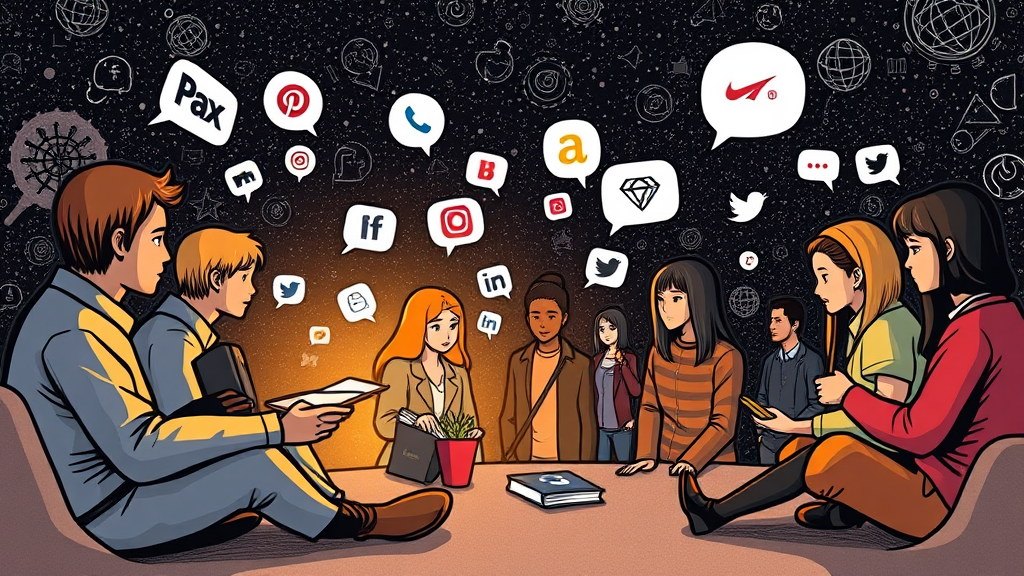Viral marketing trends have become one of the most powerful forces shaping consumer behavior. A single TikTok challenge, influencer endorsement, or trending hashtag can turn an unknown product into an overnight sensation.
The rapid nature of social media means trends can rise within hours, with thousands—sometimes millions—of consumers rushing to buy products without second-guessing their purchasing decisions. For businesses, this presents both a massive opportunity and a significant challenge. If leveraged correctly, viral trends can lead to explosive sales growth, increased brand recognition, and a loyal customer base. However, failing to understand the dynamics behind viral trends may result in short-lived hype that fades away quickly, leaving businesses scrambling to retain customers.
From the “TikTok Made Me Buy It” phenomenon to the unexpected comeback of vintage fashion and nostalgic brands, viral marketing trends determine what people desire, how they shop, and how businesses promote their products.
But what makes a trend go viral? Why do consumers rush to buy products just because they are trending? And more importantly, how can businesses use viral marketing trends to drive long-term sales rather than getting lost in short-lived hype?
The Lifecycle of a Viral Trend: From Hype to Saturation
Viral marketing trends follow a predictable lifecycle, often starting in small communities, gaining mass appeal, and eventually fading away. While some trends evolve into lasting consumer habits, others lose relevance as quickly as they rose to fame. Understanding this lifecycle allows businesses to strategically time their engagement, ensuring they maximize profits before interest wanes.
1. The Birth of a Viral Trend
Most viral trends begin within niche communities before making their way to the mainstream market.
- Influencers, trendsetters, or early adopters introduce a product to their small yet engaged audience.
- The product resonates due to novelty, uniqueness, or perceived value, sparking organic conversations.
- As social media users share their experiences, the trend gains momentum, reaching a wider audience.
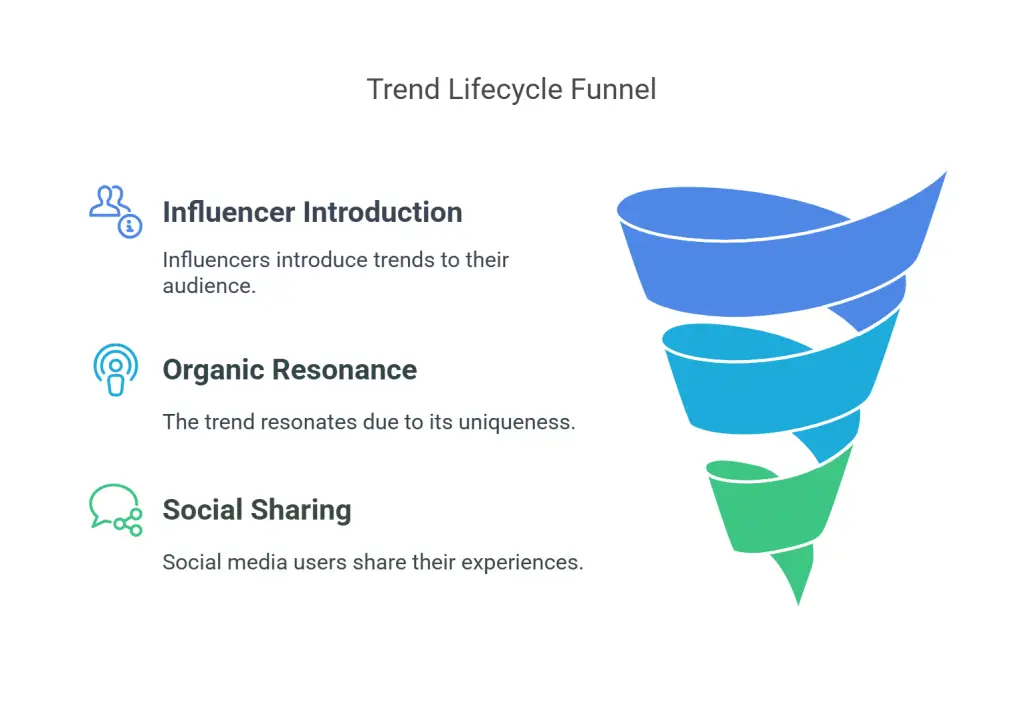
👉 Example: The rise of fidget spinners began in online gaming communities before exploding into mainstream toy markets.
2. The Peak: Maximum Influence on Buying Decisions
Once a product achieves mainstream virality, it reaches its peak demand, causing an explosion in sales.
- Consumers rush to buy the product due to FOMO and social proof.
- Many brands struggle to keep up with production, leading to stock shortages and inflated resale prices.
- Media coverage and celebrity endorsements further drive demand, making the product a cultural phenomenon.
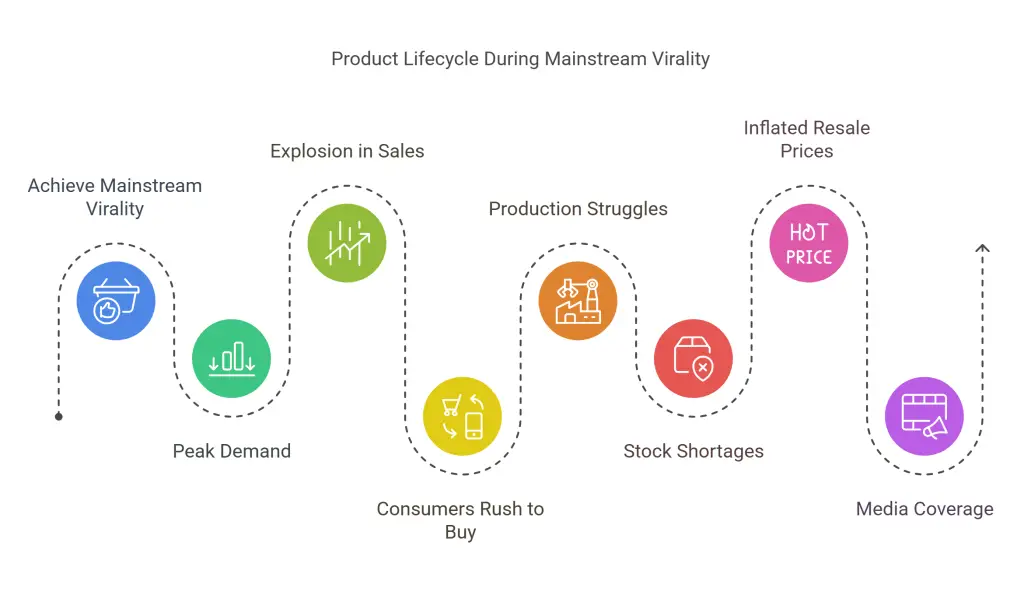
👉 Example: The Nike Dunk sneaker boom, fueled by social media hype, resulted in immediate sellouts and skyrocketing resale prices.
3. The Saturation Point: When Trends Fade
When a product becomes too widely available, it loses its exclusivity, leading to consumer fatigue.
- The market becomes flooded with copycat versions and cheaper alternatives.
- Interest declines as consumers seek the next trending product.
- Many businesses face unsold inventory issues, leading to steep discounts and liquidation sales.
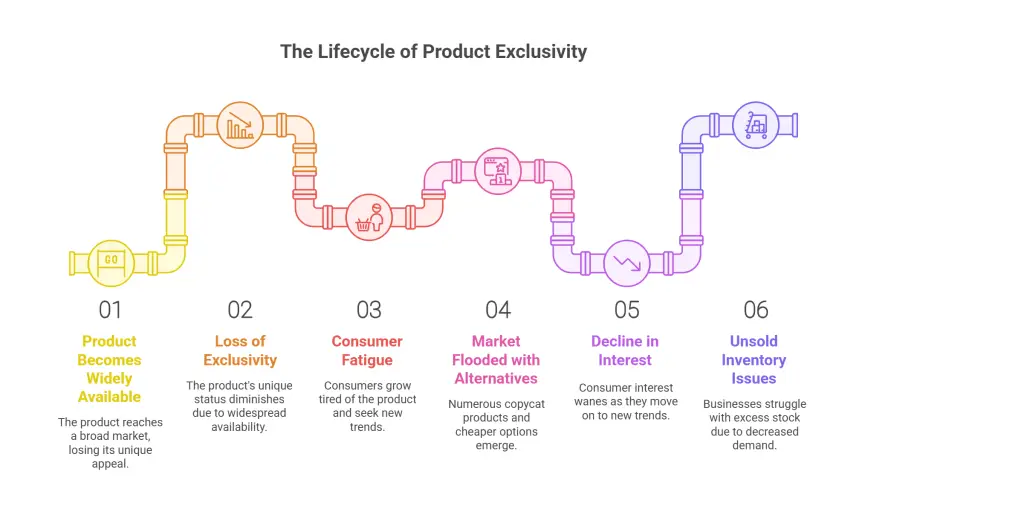
👉 Example: The fall of hoverboards—once a top-selling holiday gift—quickly faded after safety concerns and oversaturation.
4. The Aftermath: Evolution or Decline
Some viral trends transition into long-term market staples, while others disappear entirely.
- Products that offer lasting value or brand loyalty continue thriving.
- Others lose relevance due to changing consumer preferences.

👉 Success Example: Apple AirPods began as a meme-worthy trend but became an industry standard in wireless audio.
👉 Failure Example: Fidget spinners, after peaking in popularity, disappeared once their novelty wore off.
Understanding this lifecycle allows businesses to adapt their marketing strategies—either capitalizing on short-term trends or positioning products for long-term success. 🚀
The Psychology Behind Viral Marketing Trends
1. The Fear of Missing Out (FOMO) Effect
Psychologists have long studied how social influence affects consumer behavior, and one of the strongest psychological triggers in viral purchasing is FOMO—Fear of Missing Out. The modern consumer lives in a world where constant social media updates, influencer promotions, and peer recommendations create an overwhelming sense of urgency.
Think about it: If you see your friends or favorite influencers raving about a product online, you may feel left out if you don’t join in. This is why limited-time offers, countdown timers, and “selling out soon” alerts create an almost panic-like urgency that pushes consumers to buy immediately—even if they weren’t planning on it.
FOMO is one of the core reasons why viral marketing trends work so effectively. When a product explodes in popularity overnight, consumers want to secure it before it disappears. Businesses often intentionally create scarcity (e.g., Nike’s limited-edition sneaker drops) to fuel this psychological response.
- Limited-edition releases, countdown timers, and “sold out” notifications create a sense of scarcity.
- Influencer marketing amplifies FOMO, making products appear exclusive and desirable.
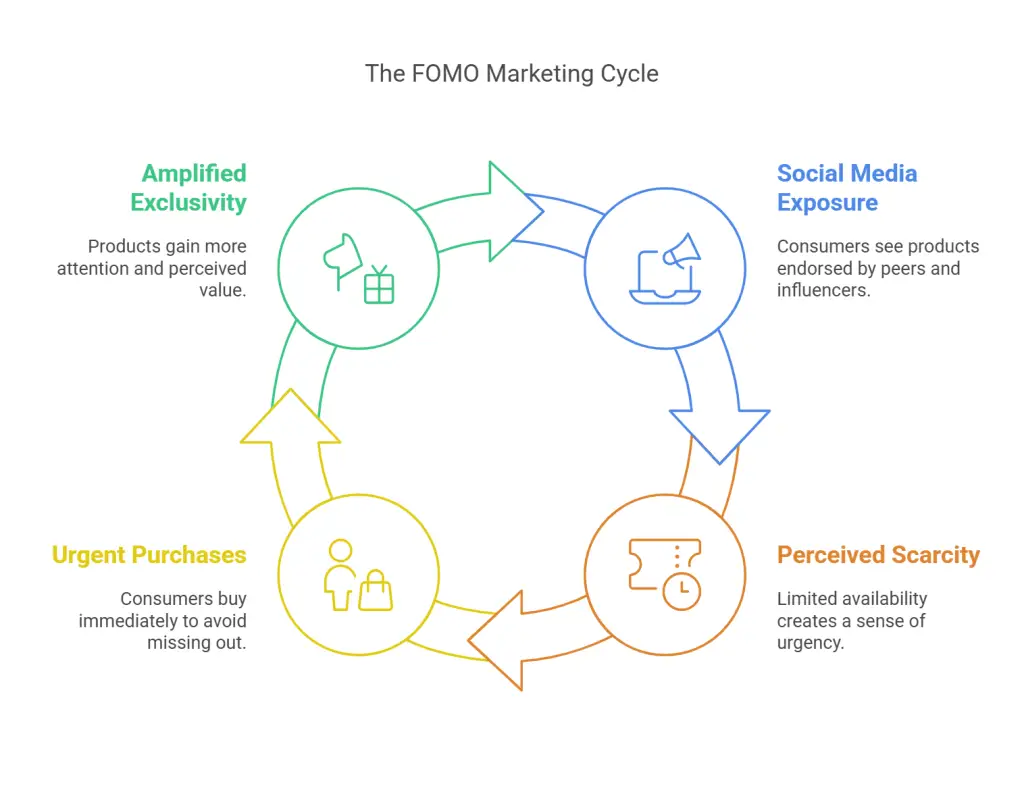
Example:
The Stanley Quencher Cup, a reusable tumbler, became a viral hit after influencers showcased its sleek design and durability. As demand skyrocketed, it sold out multiple times, leading to resale prices doubling on platforms like eBay.
👉 Lesson for businesses: Creating limited-edition releases or timed offers can help fuel FOMO and increase demand in viral marketing trends.
2. Social Proof & The Bandwagon Effect
Humans are deeply wired to trust and follow the crowd. Psychologists call this the Bandwagon Effect, where individuals adopt certain behaviors simply because others are doing it. When thousands of people rave about a product online, it creates a perception of quality and desirability—even if consumers haven’t tested it themselves.
This is why customer reviews, testimonials, and influencer recommendations are more powerful than direct advertising. A brand may claim its product is “the best,” but if thousands of regular users are saying the same thing, it feels more credible and trustworthy.
The effect is amplified on social media, where a single viral post can generate thousands of shares, comments, and purchases within hours. This creates a snowball effect—the more people buy, the more others feel compelled to do the same.
- User-generated content, influencer testimonials, and viral reviews amplify social proof.
- People are more likely to purchase something if they see friends, celebrities, or social media influencers using it.
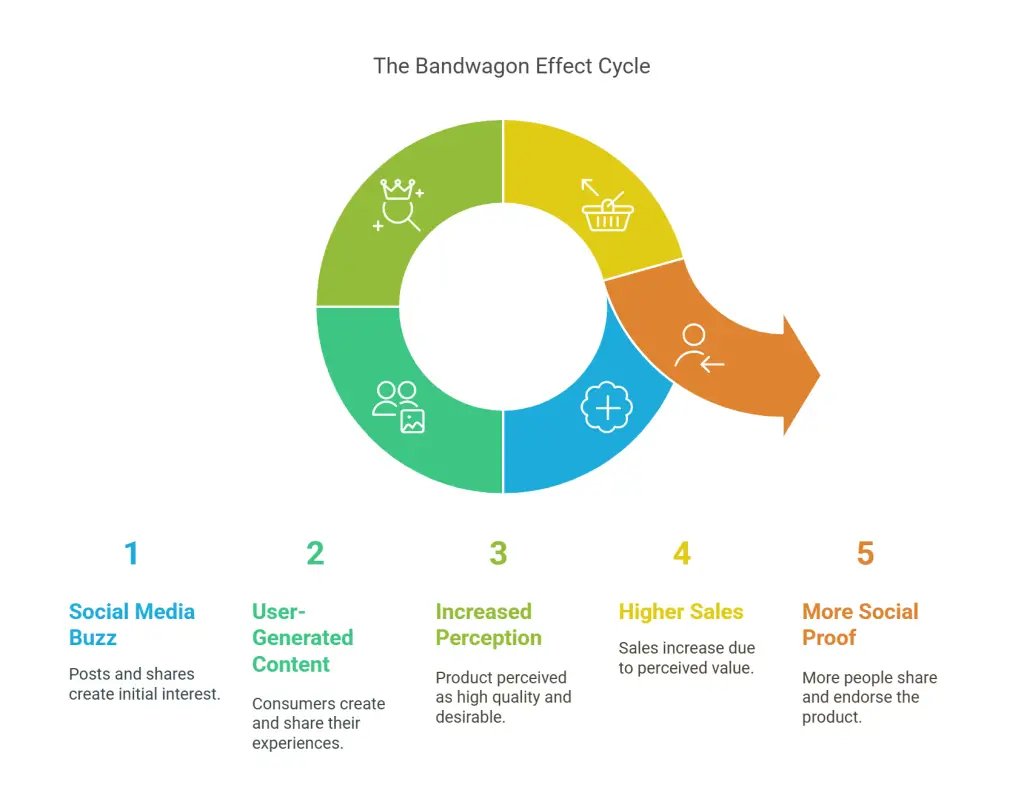
Example:
The Dyson Airwrap hair styling tool gained massive popularity through TikTok reviews and influencer recommendations. Despite its high price, consumers were convinced of its value through social proof, leading to constant sellouts.
👉 Lesson for businesses: Encouraging real customer reviews, unboxing videos, and user-generated content can significantly boost social proof in viral marketing trends.
3. Dopamine & Instant Gratification
Ever wonder why online shopping feels so addictive? The answer lies in dopamine, the brain’s “feel-good” chemical. Social media platforms hijack our brain’s dopamine system, making shopping feel rewarding and exciting, which is a key driver in viral marketing trends.
When consumers scroll through social media, they are constantly exposed to engaging videos, trending products, and influencer promotions. Seeing a product in action—whether through a short-form video or a glowing review—triggers a spike in dopamine. This chemical release creates a strong emotional response, making consumers feel they must buy the product to experience the same joy.
- Short-form video content (TikTok, Instagram Reels, and YouTube Shorts) accelerates trend cycles, driving impulse purchases.
- One-click buying and fast shipping satisfy the need for instant gratification.
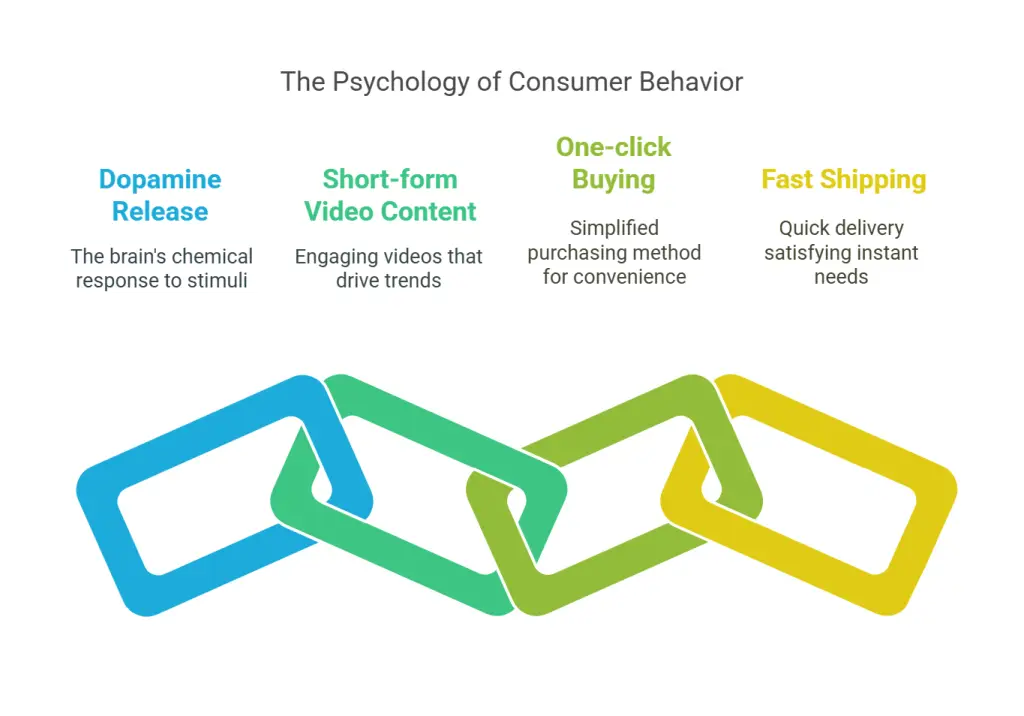
Example:
Amazon’s “Buy Now” button and same-day shipping have made impulse purchases even more tempting, further reinforcing dopamine-driven shopping behavior.
👉 Lesson for businesses: Simplifying the purchase process (one-click checkout, fast shipping) can increase conversion rates and enhance viral marketing trends success.
How Businesses Can Leverage Viral Trends to Increase Sales
Viral trends present an exciting opportunity for businesses, but they also require quick adaptation and smart execution to convert short-lived hype into sustained success. Many brands struggle to keep up with the fast-paced nature of social media, missing out on massive revenue spikes because they fail to react in time. On the other hand, those who identify trends early, align their products strategically, collaborate with the right influencers, and move quickly can experience exponential sales growth.
The key to success lies in understanding how trends form and evolve. Businesses must stay agile, track emerging trends in real-time, and adjust their marketing strategies accordingly. Whether it’s through product adaptation, influencer partnerships, or fast execution, companies that harness the power of viral marketing trends can create lasting brand impact instead of short-term gains.
Below are four critical strategies businesses can use to leverage viral trends for long-term growth and increased sales.
1. Monitor & Identify Emerging Trends
The most successful brands don’t wait for a trend to reach its peak—they spot and adapt to emerging trends before the competition does. Being an early adopter of viral trends gives businesses a major competitive edge by allowing them to establish dominance in the market before saturation.
- Use data-driven tools like Google Trends, TikTok Insights, and Instagram analytics to track rising trends before they explode.
- Monitor trending hashtags, viral challenges, and influencer collaborations across social platforms.
- Observe competitor strategies—if rival brands are starting to adopt a trend-driven approach, it may be time to act quickly.
Businesses that proactively track and analyze trends will be better positioned to capitalize when consumer demand reaches its peak.
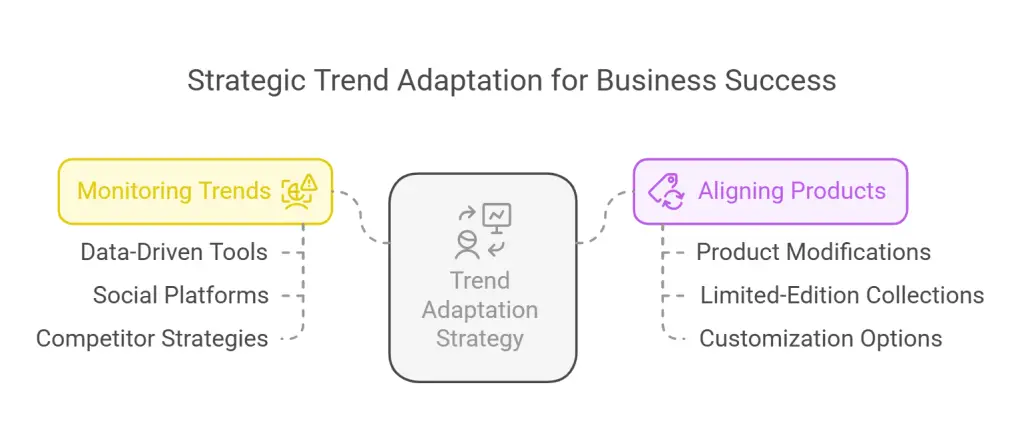
2. Align Products With Viral Demand
Once a viral trend gains momentum, businesses should adjust their offerings to align with consumer demand. This doesn’t always mean creating entirely new products—sometimes, it’s as simple as tweaking existing items to match popular aesthetics, colors, or functionalities.
- Modify product packaging, branding, or messaging to align with viral aesthetics.
- Launch limited-edition collections to create exclusivity and urgency, driving higher sales.
- Offer customization options that allow consumers to personalize products based on trending preferences.
Companies that fail to adapt their products to market trends risk missing out on sales and losing relevance as consumers flock to competitors who capitalize on viral demand.
3. Partner With Influencers to Drive Trend-Based Sales
Influencer marketing plays a crucial role in viral marketing trends. Consumers trust recommendations from influencers more than traditional ads, making influencer partnerships one of the most effective ways to drive trend-based sales.
- Work with authentic influencers whose audience aligns with your brand and niche.
- Encourage creative, natural storytelling rather than scripted, overly promotional content.
- Consider partnering with micro-influencers who have high engagement rates and can influence niche communities.
A well-executed influencer marketing strategy can amplify brand visibility, drive instant credibility, and create long-term customer loyalty.
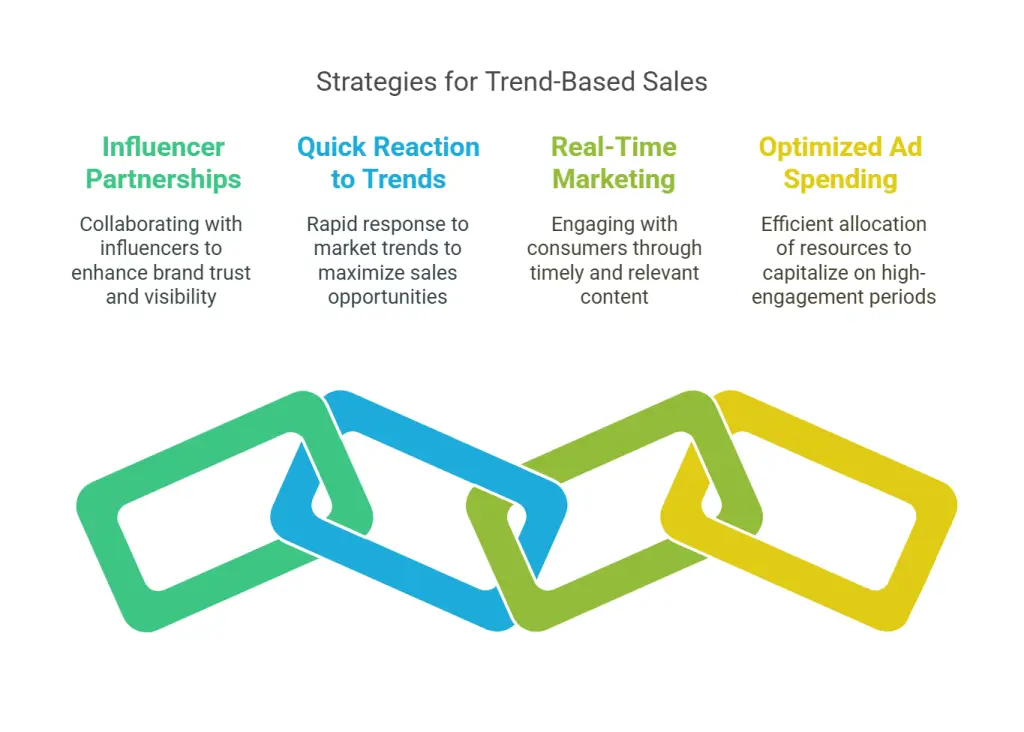
4. Move Fast—Trends Have Short Lifespans
Timing is everything when it comes to viral marketing trends. A trend that’s hot today may be irrelevant tomorrow, which means businesses must act fast to capture consumer interest before it fades.
- React quickly by launching timely campaigns, promotions, and collaborations.
- Invest in real-time marketing efforts such as TikTok challenges, Instagram Reels, and Twitter engagement.
- Optimize ad spending to capitalize on high-engagement windows before trends fade away.
Companies that move swiftly can maximize sales opportunities, stay ahead of competitors, and maintain brand relevance long after the trend subsides.
Case Study: The Rise and Struggles of TrendWear Apparel
TrendWear Apparel, a small streetwear brand founded by Jason, was built on the idea of staying ahead of fast-moving fashion trends. Jason, a 29-year-old entrepreneur with a background in digital marketing, believed that leveraging viral marketing trends would help him compete with larger fashion brands.
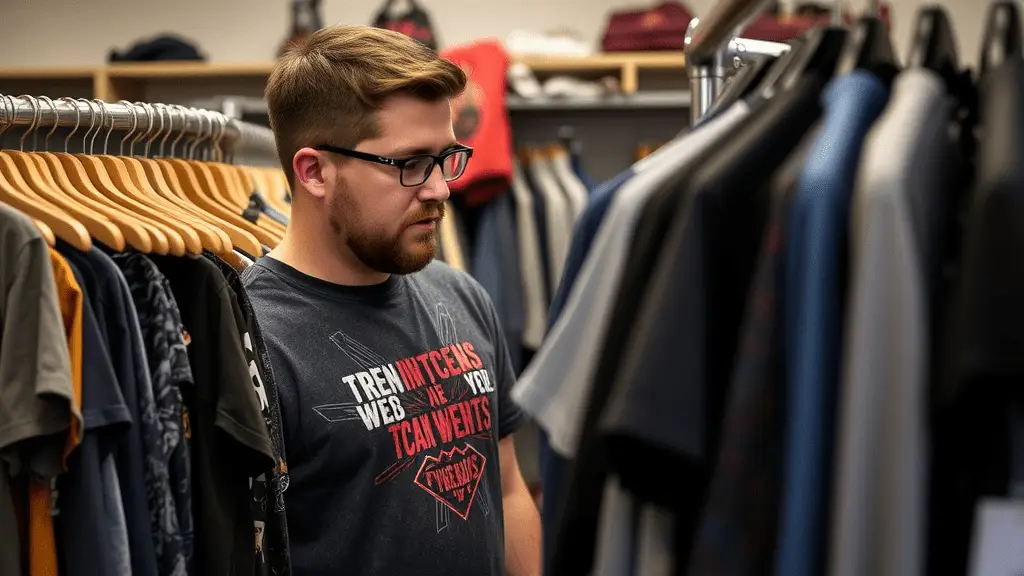
Armed with a team of two social media managers and a handful of outsourced designers, TrendWear aimed to capitalize on TikTok-driven fashion trends, hoping that a single viral moment could catapult their brand into mainstream success.
However, riding the wave of virality proved harder than expected.
Early Failures: The Struggle to Go Viral
Jason’s first attempt at trend-driven marketing came in the form of a limited-edition “Hype Hoodie”, inspired by a viral TikTok aesthetic of oversized streetwear. He invested heavily in influencer marketing, sending free hoodies to several mid-tier TikTok influencers in hopes of sparking a trend.
But nothing took off. The influencers posted brief, unengaging videos, and while the hoodie received some positive comments, it never reached the explosive engagement Jason had envisioned.
The biggest mistake? Jason focused too much on the product and not enough on storytelling. The content lacked personality and urgency, failing to tap into FOMO or strong emotional appeal.
Sales trickled in, but the ROI was disappointing, leaving TrendWear with excess inventory and a lesson learned—going viral is more than just paying influencers; it’s about crafting an engaging narrative.
Turning Mistakes into Marginal Success
Determined not to give up, Jason shifted his strategy. This time, he analyzed successful viral fashion campaigns and identified a growing trend in “Y2K nostalgia” streetwear.
Instead of just creating a product and hoping it would go viral, Jason engaged directly with his audience. He:
✔️ Created TikTok challenges that encouraged users to style TrendWear outfits.
✔️ Partnered with micro-influencers who were deeply connected to niche fashion communities.
✔️ Released a limited-edition Y2K Collection with built-in scarcity and exclusivity.
This time, results were promising—while not a massive viral hit, TrendWear saw a 35% increase in sales, better engagement, and stronger community involvement.
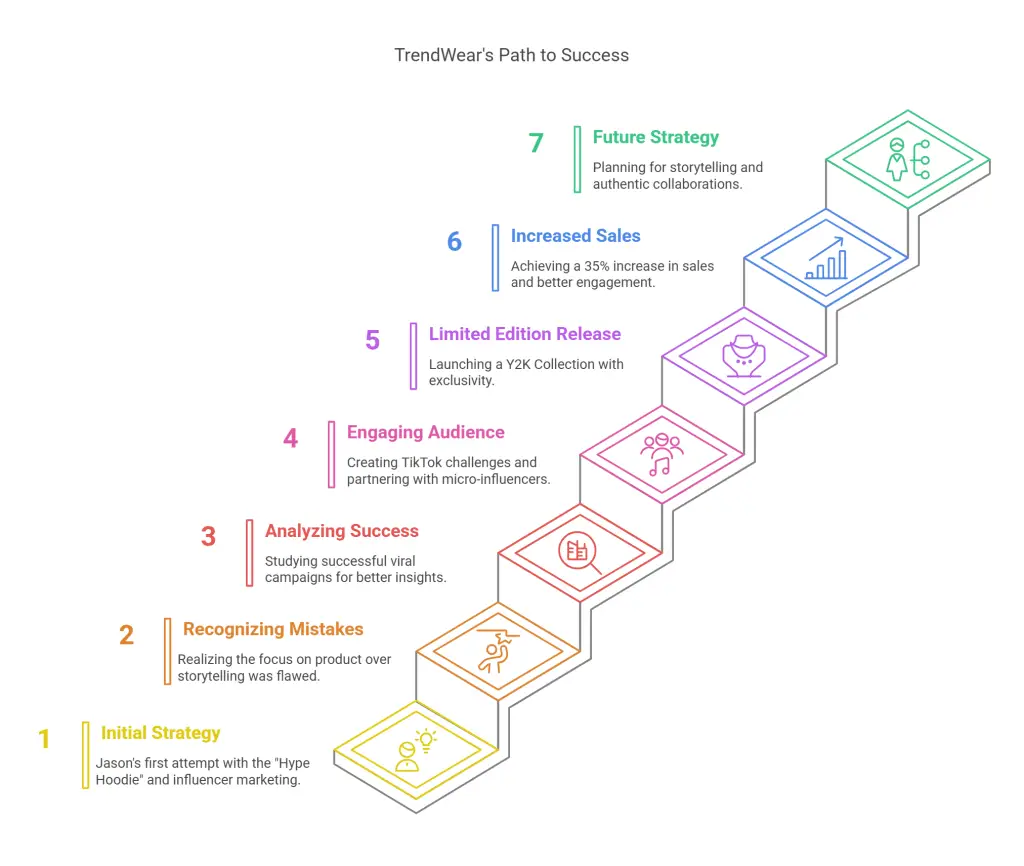
Looking Forward: Lessons for the Future
Jason acknowledged that chasing virality without a strategy was a mistake. Moving forward, TrendWear will:
✅ Invest in storytelling—every campaign needs an emotional hook.
✅ Build a stronger influencer network, focusing on authentic collaborations.
✅ React faster to emerging trends, but only when they align with the brand’s identity.
Jason remains optimistic, knowing that long-term success comes from consistency, adaptability, and learning from past mistakes. 🚀
Ethical Considerations in Viral Marketing
While viral trends can drive massive sales and brand awareness, businesses must also consider the ethical implications of leveraging consumer psychology. Some brands intentionally create artificial scarcity or manipulate emotions to drive urgency—but is that ethical?
In an era where consumers are becoming more aware of marketing tactics, brands that prioritize transparency and integrity will build trust and long-term loyalty rather than one-time sales spikes. Below are two major ethical concerns that businesses must navigate when using viral marketing trends.
1. Is It Ethical to Exploit FOMO?
FOMO (Fear of Missing Out) is a major driver behind impulse buying, and brands often leverage this emotion to push consumers into quick purchases. While creating scarcity-based marketing can boost sales, exploiting consumer anxiety for profit can backfire.
- Some brands intentionally limit supply or fake “selling out” notices to create artificial urgency.
- Ethical marketing should focus on quality and value, rather than manipulating consumer emotions.
- Long-term trust is far more valuable than short-term sales gains.
👉 Best Practice: Create genuine exclusivity through limited-edition products or seasonal releases, rather than false urgency tactics.
2. Privacy Concerns in Trend-Based Marketing
Social media platforms track user behavior to predict and promote viral trends, raising serious privacy concerns. Many consumers don’t realize how much of their data is collected, and as awareness grows, trust in brands can erode if businesses fail to prioritize ethical data usage.
- Be transparent about data collection practices—let users know how their interactions influence marketing strategies.
- Avoid invasive retargeting techniques that make consumers feel like they’re constantly being watched.
- Comply with privacy laws (such as GDPR and CCPA) to ensure ethical marketing practices.
👉 Best Practice: Prioritize ethical, permission-based data collection, and give consumers more control over their online experience.
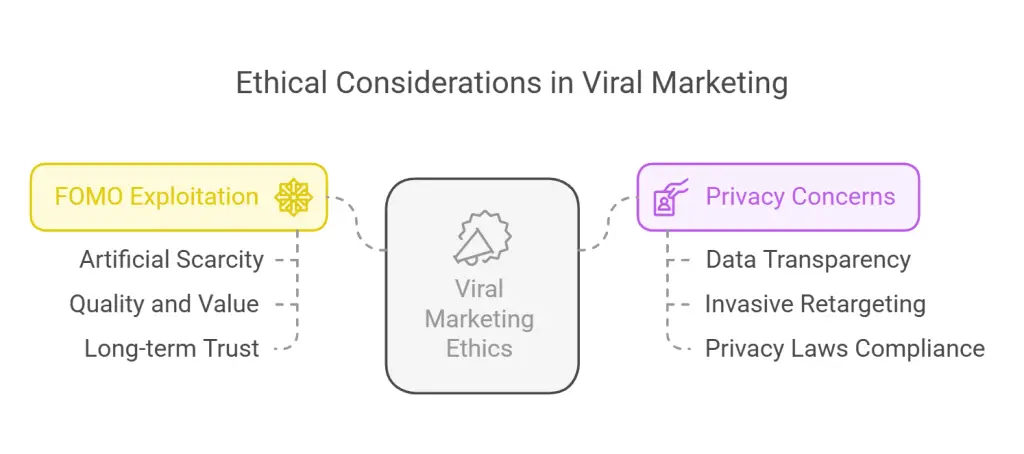
Conclusion: Balancing Hype With Long-Term Strategy
Viral trends undeniably shape modern buying behavior, influencing what consumers purchase and how brands operate. However, not all viral moments translate into sustainable business success. Brands that focus only on hype without delivering real value often fade away as quickly as the trend itself.
Businesses must strike a balance between short-term momentum and long-term brand building. While leveraging viral trends can boost visibility and sales, companies that consistently provide high-quality products, exceptional customer experiences, and ethical marketing practices will outlast the viral cycle and remain relevant in an ever-changing digital landscape.
Key Takeaway:
Trends come and go, but brands that focus on quality, trust, and engagement will outlast the viral cycle, turning fleeting popularity into sustained business success. 🚀
Frequently Asked Questions
What is viral marketing?
Viral marketing is a strategy where consumers share a company’s message, leading to rapid and widespread dissemination, similar to how a virus spreads. It leverages social networks to increase brand awareness or achieve marketing objectives.
How does viral marketing differ from traditional marketing?
Unlike traditional marketing, which relies on direct promotion, viral marketing depends on consumers to voluntarily share content, amplifying the message’s reach organically and often more credibly.
What factors contribute to a successful viral marketing campaign?
Key factors include crafting memorable and engaging messages, targeting individuals with high social networking potential, and launching campaigns in environments conducive to sharing.
Can you provide an example of a successful viral marketing campaign?
Hotmail’s strategy of adding “Get your free e-mail at Hotmail” to every sent email led to rapid user growth, exemplifying effective viral marketing.
What are the risks associated with viral marketing?
Risks include loss of message control, potential negative word-of-mouth, and the possibility of the campaign reaching unintended audiences, leading to misalignment with the brand’s target market.
Further reading
Crowdspring. “Viral Marketing: What It Is, Why It Works, and How to Do It Right.” Crowdspring Blog, March 18, 2022. https://www.crowdspring.com/blog/viral-marketing/. Last accessed February 18, 2025.
Investopedia. “Viral Marketing: Definition, Advantages, and Examples.” Investopedia, last modified October 10, 2023. https://www.investopedia.com/terms/v/viral-marketing.asp. Last accessed February 18, 2025.
Filestage. “10 of the Best Viral Marketing Campaigns (and What You Can Learn from Them).” Filestage Blog, April 25, 2023. https://filestage.io/blog/best-viral-marketing-campaigns/. Last accessed February 18, 2025.
Shopify. “Viral Marketing: How to Create Campaigns That Get People Talking.” Shopify Blog, March 1, 2023. https://www.shopify.com/au/blog/viral-marketing. Last accessed February 18, 2025.
StudioID. “How to Go Viral: 10 Trending Marketing Campaigns & the Science Behind Them.” Springboard by StudioID, August 15, 2023. https://www.studioid.com/springboard/how-to/how-to-go-viral-10-trending-marketing-campaigns-the-science-behind-them/. Last accessed February 18, 2025.
Birch. “The Ultimate Viral Marketing Strategy Guide.” Birch Blog, September 5, 2023. https://bir.ch/blog/viral-marketing-strategy. Last accessed February 18, 2025.
House of Marketers. “The Ultimate TikTok Trends and Brands Viral Marketing Guide.” House of Marketers, December 11, 2023. https://www.houseofmarketers.com/tiktok-trends-brands-viral-marketing-guide/. Last accessed February 18, 2025.





